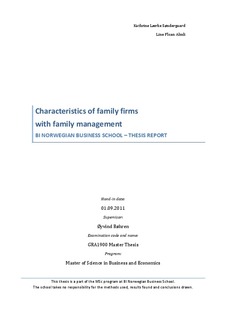| dc.description.abstract | In this paper we examine what characterizes family firms’ decisions when it comes to having a family member being the CEO or the chairman of the board of the company. We define this as family management, which is the dependent variable in our research. This variable has four non-ordered mutually exclusive values; family CEO, family chairman of the board, family CEO and family chairman of the board, and neither family CEO nor family chairman of the board. Using data from the Center for Corporate Governance Research (CCGR) we have analyzed approximately 79,000 Norwegian private family firms. Based on a thorough literature review we chose performance, firm size, firm age, family ownership stake, fraction of family board members, and industry risk as our independent variables in the base case model. We find that some determinants of family management are the same for all categories of family management, while other determinants make the choice differ. The choice of having a family CEO is more likely in large firms, with high family ownership stake and low industry risk, whereas the choice of having a chair is more likely in small firms with low family ownership stake. The choice of having family members in both positions is more likely in small firms with a high family ownership stake and low industry risk. This shows that the combination of characteristics determines what type of family management family firms choose. We also find that family management overall is more likely in young family firms with high performance and a high fraction of family members on the board. This shows how the choices are related as well as how they differ. Conversely, family firms are more likely to replace a family member in the management subsequent to low performance, if the firm is older, or if there is a low fraction of family members on the board. An analysis of the findings indicates that families both hold and use control in order to secure the management positions, especially when the fraction of family members on the board is high. Nevertheless, it seems that families, opposed to earlier, now need and want a higher ownership stake before taking this control, which illustrates a seemingly positive trend. These two opposing forces are the most interesting finding throughout the paper, and demonstrate what can be changing governance mechanisms. | no_NO |
